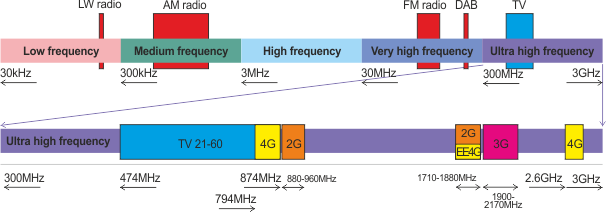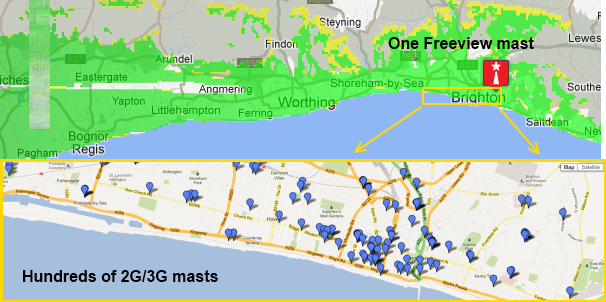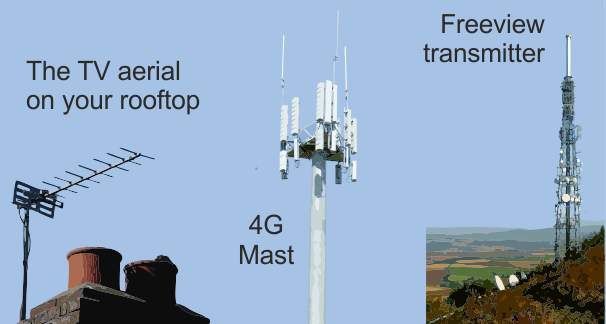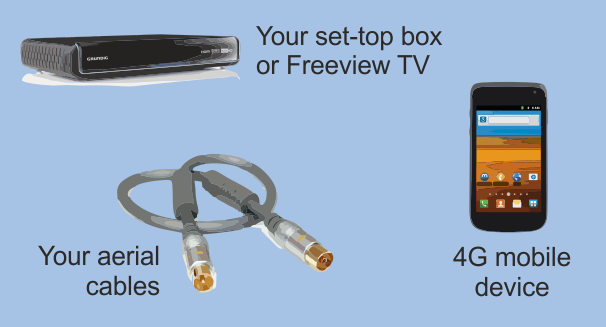How do I know if the 4G broadband will overload my Freeview?
 Brian Butterworth published on UK Free TV
Brian Butterworth published on UK Free TV Back in June 2011, we looked at how Ofcom moves to protect Freeview interference from 4G mobile .
Since then, the television Digital Switchover has been finished and 4th generation (4G) mobile broadband services - also known as Long Term Evoluition (LTE) have launched all over the world, including a service from Everything Everywhere (EE) in the UK.
To understand why and how these 4G broadband services will cause problems during 2013, you need to take into consideration a number of technical factors.
Understanding the radio spectrum
The Radio spectrum is the name given to the frequencies of the electromagnetic spectrum that can be usefully used to transmit radio, television and data services.The top bar on the diagram below (or download) shows a selection of the services used in the UK, with old-fashioned long-wave radio, then medium-wave radio, though FM radio, the digital DAB radio services up to those used for television broadcasting. (See here for a really complex chart).

The highest frequencies on the diagram, the "ultra high frequencies" (or UHF) band is shown enlarged as the lower purple bar. In this range we can see TV "channels C21 to C60" (blue), second- and third- generation mobile phones (2G orange, 3G pink) and the location for the 4G services.
It is important to note that some of the 2G capacity in the "1800MHz" range has already been converted to 4G operation by Everything Everywhere (EE). The other two yellow boxes show the "800MHz" (to the left) "2.6GHz" (on the right).
For the purpose of Freeview reception, only the 800MHz range need be considered. The other two ranges will not cause Freeview problems.
Protecting Freeview receivers against overload
As we have seen already - Freeview signals: too much of a good thing is bad for you - Freeview boxes are designed to protect themselves against signal overloads. When they do this they close down and people often incorrectly diagnose the problem as being "no signal" when there is too much.The problem that has to be solved as the 4G services launch, is that the new mobile broadband signals can cause overloads onto the frequencies that are being used for Freeview.
 One particular problem is that a very common type of Freeview signal decoder, a superheterodyne receivers are sensitive to signals being present nine channels (72MHz) away.
One particular problem is that a very common type of Freeview signal decoder, a superheterodyne receivers are sensitive to signals being present nine channels (72MHz) away.
In addition to overloads, 4G may also cause Signal-Interference Noise Ratio degradation, where reception breaks down because the receiver can no longer decode the digital information in the transmission.
Knowing who will win the 4G auction
 Until the
4G auction takes place, no one will know which company has the right to use the 800MHz channels for mobile devices. The following companies have qualified to bid:
Until the
4G auction takes place, no one will know which company has the right to use the 800MHz channels for mobile devices. The following companies have qualified to bid:
- Everything Everywhere Limited (UK)
- HKT (UK) Company Limited (a subsidiary of PCCW Limited)
- Hutchison 3G UK Limited
- MLL Telecom Ltd
- Niche Spectrum Ventures Limited (a subsidiary of BT Group plc)
- Telefonica UK Limited
- Vodafone Limited
Viewing high power television and using low power mobiles
Using the 'Sitefinder' Mobile Phone Base Station Database you can compare the locations of existing mobile phone "masts" with those used for Freeview Transmitters. Here is an example from Brighton and Hove, where a medium-sized single mast (Whitehawk Hill) can cover a whole city, but where hundreds of mobile phone base-stations cover a many smaller-by-comparison areas.
This illustrates two points. Firstly, that Freeview broadcasts are high powered and one-to-many - mobile devices are low power and peer-to-peer. The mast your TV signal comes from may be miles, sometimes tens or miles away, for your mobile perhaps only meters away.
The second point is that if an existing 2G/3G mobile supplier wins a 800MHz 4G slot, they will wish to use their existing "phone mast" locations (especially the 900MHz ones) as this would be most economical for them. Until the action winners emerge, and then plan their network, only idle speculation about possible interference can be made.
Using the TV frequencies for 4G masts and phones
Research (see here) shows that a 4G mast in relative close proximity, or a mobile 4G handset closer than a meter to an unfiltered Freeview box will cause overloading on many tested devices. The following diagram shows the relationship between the 4G use and the old TV channel designations.
Those Freeview transmitters that use channels above C52 are most likely to have receivers that get overloaded by the use of 4G signals in the 800MHz area. FDD is Frequency-division duplexing - the transmitter and receiver operate at different carrier frequencies.
Interpreting the aerial and mast locations
Once the proposed mast locations for 4G services are known, it will then be possible to predict which homes will need to fit the special filters in areas where Freeview uses the higher channel numbers (the C52 to C60 range).
If you then have a rooftop aerial without a signal amplifier, to get an overload you will need the 4G mast to be in the line-of-sight between your Freeview transmitter and the aerial, or possibly "directly behind" the aerial.
If you then have a rooftop aerial and an amplifier, or perhaps have lower-grade cables, you are likely to need to protect from a 4G overload if the phone mast is close to your rooftop aerial.
Finding transmitters that use the higher range frequencies
Some powerful transmitters and many relays use the high frequencies: Sudbury, Oxford, Belmont, Winter Hill, Tacolneston, Pontop Pike, Mendip, Emley Moor, Clermont Carn, Truskmore and Maghera.Click below to find out the transmitters in with high frequency allocations:
- C60 is used by 126 transmitters - including Sudbury, Oxford, Belmont;
- C59 is used by 142 transmitters - including Winter Hill and Tacolneston;
- C58 is used by 100 transmitters - including Winter Hill, Sudbury, Pontop Pike and Mendip;
- C57 is used by 131 transmitters - including Clermont Carn, Truskmore, Oxford;
- C56 is used by 73 transmitters - including Mendip, Sudbury;
- C55 is used by 139 transmitters - including Maghera, Winter Hill and Tacolneston ;
- C54 is used by 104 transmitters - including Mendip, Pontop Pike and Winter Hill;
- C53 is used by 131 transmitters- including Truskmore, Belmont, Oxford;
- C52 is used by 81 transmitters - including Emley Moor, Sandy Heath, Clermont Carn and Mendip.
Protecting Freeview boxes and sets, cables, amplifiers from 4G devices
Again in areas where Freeview uses the higher channel numbers (C52 and above) you may have to protect your Freeview devices from signals from a 4G handset (such as mobile phone, tablet, or USB "dongle").
This may, once again, require the fitting of a special filter, or the upgrading of the "fly leads" used to connect your aerial to the set top box or TV. This may be a particular problem if you have used an indoor aerial or signal amplifier.
Help with TV/radio stations?
In this section
Monday, 4 March 2013
It's all very well wanting to use the former TV UHF channels 61-69 for future 4G LTE. To get decent analogue / digital TV reception of C61-69, you needed a decent aerial, ideally group C/D. So does this mean you'll need a group C/D aerial for a 4G mobile phone? Even the smallest C/D aerial (10 elements) intended for a storng singnal area is quite big; way too big and impractical for people to carry around for use with their mobile phone / smartphone.
| link to this comment |
Nicholas Willmott: Normal mobile phone internal aerials are used for LTE. That is all that is required.
| link to this comment |
Thanks Briantist. It amazes me that a tiny internal aerial will work for a mobile phone in the 791-862 MHz range, yet that same frequency range (C61 to C69) required such large group C/D aerials (ideally rooftop mounted) for decent TV reception. How is it possible to for such a minute aerial as used in a mobile phone work for a 4G LTE mobile phones, yet not for TV. It's the same frequency range at the end of the day.
| link to this comment |
Further to my last post, I've looked at the complex frequency chart mentioned at the top of this page. I see that the range 275.0GHz to 300GHz is labelled Not Allocated. If that range is not allocated (vacant), why don't they use that range for 4G LTE, and not bother using the former UHF channels 60 to 69?
| link to this comment |
Nicholas Willmott: Yes the same frequency range but with transmitters much closer! You have to remember that if you live nest to a freeview transmitter chances are you don't need an aerial to pick up freeview! (I have done this with Wenvoe!) There will be many many 4g transmitters dotted around like mobile phone masts meaning that the signal will be strong enough to pick up with the tiny phone antenna.
| link to this comment |
Also the reason that they want to use the 800MHz range for 4g as it is (please correct me if I'm wrong!) a sweet spot. I.e. it will work better within these frequencies than any other.
| link to this comment |
Tuesday, 5 March 2013
J
Jo Dee10:27 AM
Worcester
Hello, I live in Worcester and since Dec 2012, I have experienced random, intermittent signal quality problems, that I have never had prior to late Dec.
My TV set-up function tells me the TV signal is strong, but the signal quality is poor or non existent. Sometimes it seems to affect certain channels, sometimes all, but more often than not we are left with only awful shopping channels, which we don't watch anyway!
Can you tell me what is going on & what to do about it? Our TV ariel seems fine & on the days the signal quality doesn't drop out, we have an excellent picture.
Any advice would be very much appreciated.
| link to this comment |
Jo's: mapJ's Freeview map terrainJ's terrain plot wavesJ's frequency data J's Freeview Detailed Coverage
Thursday, 7 March 2013
Jo Dee: It could be a number of things really. What I find if the signal is strong but quality poor is an amplifier (if you have one) is failing. Although in your case as it is intermittent that would seem unlikely. Does the aerial lead go straight into the back of the TV/freeview box? or does it go through an old video recorder first? If the latter try running the cable straight into the TV/freeview box.
Do you notice it gets worse when it rains? If so you may have water getting into the system. Lastly, is there an aerial socket in the wall? or does the cable come straight through the wall? If there is a socket the problem could lie there.
Andy
| link to this comment |
Sunday, 10 March 2013
S
Steven Tracey9:47 PM
Bristol
For the last week we have been unable to receive BBC stations (any) but the ITV (1,2, Channel 4, 5 etc) set are still available.
TV has been checked. Aerial hasn't been moved/touched.
Any thoughts?
Many thanks.
Steven
| link to this comment |
Steven's: mapS's Freeview map terrainS's terrain plot wavesS's frequency data S's Freeview Detailed Coverage
Monday, 11 March 2013
Steven Tracey: What is your postcode as it is difficult to give technical info without first knowing exactly where you are.
Andy
| link to this comment |
Select more comments
Your comment please!